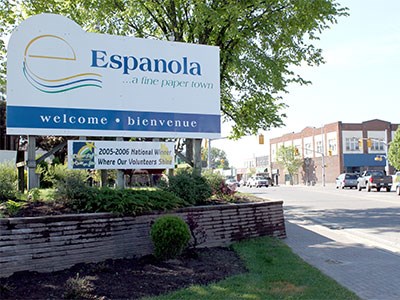Call Espanola the little community that could.
In 2013, a reassessment of the Domtar sawmill by the Municipal Property Assessment Corp. (MPAC) threw the community for a loop. According to MPAC, Espanola owed the sawmill $4 million after Domtar paid too much in taxes — dating back to 2009. The town would have had to raise property taxes by 50 per cent in order to recover and pay back the funds.
It’s not an easy task for a small community of just over 5,000, and the decision forced the town to re-examine how it does business. But that may actually not have been all bad, said Cheryl Kennelly, who took on the role of community economic development officer last May.
“Because of the Domtar reassessment, it did put a strain on our growth and change and development plan for the town, so we haven’t had the money to invest in that area,” she said. “So, not a lot has changed, but there have been a lot of positive things and that is that we are holding our own.”
The town’s allure lies in its role as a centre of business and social services for communities along the North Shore of Lake Huron. Particularly impressive is the community’s hospital, whose emergency room recently underwent a $5.9-million expansion, adding 7,000 square feet of space, for a total of 10,000 square feet.
Kennelly said patient volume has doubled from 7,000 in 1998, and space was desperately needed. Patients from as far as Sudbury have been known to travel to Espanola for hospital care, and its reputation for stellar customer service has lured others seeking to relocate there.
“When we talk to people who are moving to Espanola, they said that it’s a small community, but it’s full-service, and they were really impressed with the access to health care here,” Kennelly said.
In May, council approved a community improvement plan (CIP), which provides incentives for owners to make improvements to their businesses. Specific to the downtown area and the Highway 6 corridor that runs through town, the CIP got an immediate response from the business community. The town received several inquiries and applications and it’s currently going through the approvals process.
“In terms of that brisk uptake from our business community, that says that people are feeling that the business climate is stable in Espanola; it’s hopeful,” Kennelly said. “Because, otherwise, they wouldn’t be continuing to invest in their businesses.”
Under the CIP, business owners can apply for assistance for everything from cosmetic improvements to architectural and engineering design. There are also rebates available for demolition, landfilling and building permit fees. The town has a tax increment program in place to target developers interested in doing multi-residential building.
Espanola isn’t immune to the housing shortage facing other small communities in the North. Kennelly said the community is seeking a “healthy balance” of affordable housing, seniors housing, and multi-unit housing; in particular, she receives calls regularly from people seeking rentals.
“We have very little capacity,” she said, “and so there’s definitely a need.”
On the tourism front, Espanola is heading into the third year of its Fibre Arts Festival, held in October. Exhibitions and workshops have been well attended: the festival doubled its capacity in only its second year, and Kennelly anticipates 1,500 visitors for the 2014 edition.
“The fibre arts festival has really taken off and we’re becoming quite a sought-after fibre arts location of artists from Ontario,” Kennelly said. “It’s quite an ingestion for our town.”
Local growers have started a farmers’ market, which takes place on Thursday nights and Saturday mornings, and the town has partnered with Eastlink on a giant outdoor movie screen.
Hockey fans were buoyed last year by the return of Northern Ontario Junior Hockey League, a move that injected “spirit and dollars into our local economy and our local service sector,” Kennelly said. The town recorded the highest amount of regular audience attendance throughout the entire league, and that’s only expected to improve when franchise owner Tim Clayton adds the Rivermen to the newly formed Canadian International Junior Hockey League.
Meanwhile, the town continues to review its services and is cutting back where it can, Kennelly said.
“We’re quite the lean machine right now, and that’s not to say that that’s a bad thing,” Kennelly said. “We just have to look at how we’re doing business and we have to be more creative in how we do business as a corporation, and so we’re in that transition.”




